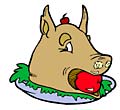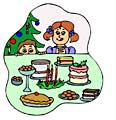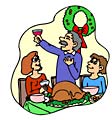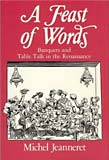|
|
 Holiday Feasting: Will You Ever Recover? Holiday Feasting: Will You Ever Recover?
by Marjorie Dorfman
Where did the idea of holiday feasting begin? Who were the first people to roll home after overindulging and can we learn from their mistakes? Is there a way through the high-cholesterol, holiday maze? Read on for some lean thoughts on a rather fattening matter.
|
 The concept of the holiday feast, as we sort of know it today is probably medieval in origin. A good feast lasted for hours, contained several courses and was designed to placate what was known then as the Four Humours. For the initiated, this has nothing to do with people who make others laugh in several different ways or additional ice cream flavors from a now defunct but well-meaning company. Medieval souls believed that the fundamental forces known as the four humors regulated the human body and that an imbalance would affect the feaster’s personality, feelings and ultimate behavior at the feasting table. The concept of the holiday feast, as we sort of know it today is probably medieval in origin. A good feast lasted for hours, contained several courses and was designed to placate what was known then as the Four Humours. For the initiated, this has nothing to do with people who make others laugh in several different ways or additional ice cream flavors from a now defunct but well-meaning company. Medieval souls believed that the fundamental forces known as the four humors regulated the human body and that an imbalance would affect the feaster’s personality, feelings and ultimate behavior at the feasting table.
Hardly as poetic as parsley, sage, rosemary and thyme, the four humors were called: melancholy, which was hot and dry; choler, which was cold and dry; phlegm, which was cold and moist; and blood, which was hot and moist. (They called the wind Maria much later.) Food in those days was prepared and eaten in a manner meant to balance all of these "humorous" forces. In terms of serving food, this meant that dry food would be boiled to add moisture to it and a moist food would be baked to insure its dryness. Certain foods would accompany each other or be spiced in a particular fashion to counteract "excess humour."
 Today, of course, things are completely different. Chances are this time of year your thighs are begging you to stop in the name of something and it isn’t love. Your tummy says no-no to all the goodies on the holiday table, but there’s yes-yes in your eyes. And why not? It’s the holidays. You work hard all year. Can’t you have a little fun, for Pete’s sake? (Was Pete skinny anyway, whoever he was?) Temptation lurks in every high cholesterol corner and behind the words of every excuse not to indulge. So what is a normal, law-abiding, God-fearing lover of sweets and other taboo things to do? How can you celebrate without over-doing it? Is such a thing possible or is it all just a gingerbread-encrusted, gumdrop dream? Today, of course, things are completely different. Chances are this time of year your thighs are begging you to stop in the name of something and it isn’t love. Your tummy says no-no to all the goodies on the holiday table, but there’s yes-yes in your eyes. And why not? It’s the holidays. You work hard all year. Can’t you have a little fun, for Pete’s sake? (Was Pete skinny anyway, whoever he was?) Temptation lurks in every high cholesterol corner and behind the words of every excuse not to indulge. So what is a normal, law-abiding, God-fearing lover of sweets and other taboo things to do? How can you celebrate without over-doing it? Is such a thing possible or is it all just a gingerbread-encrusted, gumdrop dream?
 Everyone, no matter what his or her background, has a fattening holiday feast story to tell and eat. The problem is that festivities and heavy-duty eating starts around Thanksgiving and continues for more than a month with no letup. This means your body doesn’t have a chance (fat or otherwise) to recover from all the holiday parties and treats that so characterize the season. And there’s no escape anywhere. Whether you prefer latkes fried in oil, marzipan, gingerbread, Swedish almond cookies, grog, egg nog or Italian zabaglione, your weight will more than likely swell in this what is sometimes called the "happiest time of the year." Everyone, no matter what his or her background, has a fattening holiday feast story to tell and eat. The problem is that festivities and heavy-duty eating starts around Thanksgiving and continues for more than a month with no letup. This means your body doesn’t have a chance (fat or otherwise) to recover from all the holiday parties and treats that so characterize the season. And there’s no escape anywhere. Whether you prefer latkes fried in oil, marzipan, gingerbread, Swedish almond cookies, grog, egg nog or Italian zabaglione, your weight will more than likely swell in this what is sometimes called the "happiest time of the year."
|
|
|
|
 |
|
|
Don't miss this great read:
A Feast of Words
Banquets and Table Talk in the Renaissance
by Michel Jeanneret
Translators:
Emma Hughes and Jeremy Whiteley

The banquet gives rise to a special moment when thought and the senses – words and food – enhance each other. This lively book explores these and other concepts. Michel Jeanneret explores the paradigm of the banquet as a guide to significant tendencies in Renaissance Humanist culture and shows how this culture in turn illuminates the tensions between physical and mental pleasures. Ranging widely over French, Italian, German, and Latin texts, Jeanneret not only investigates the meal as a narrative artefact but inquires as well into aspects of sixteenth-century anthropology and aesthetics.
|

Click for a printer friendly version of this article.
|
|